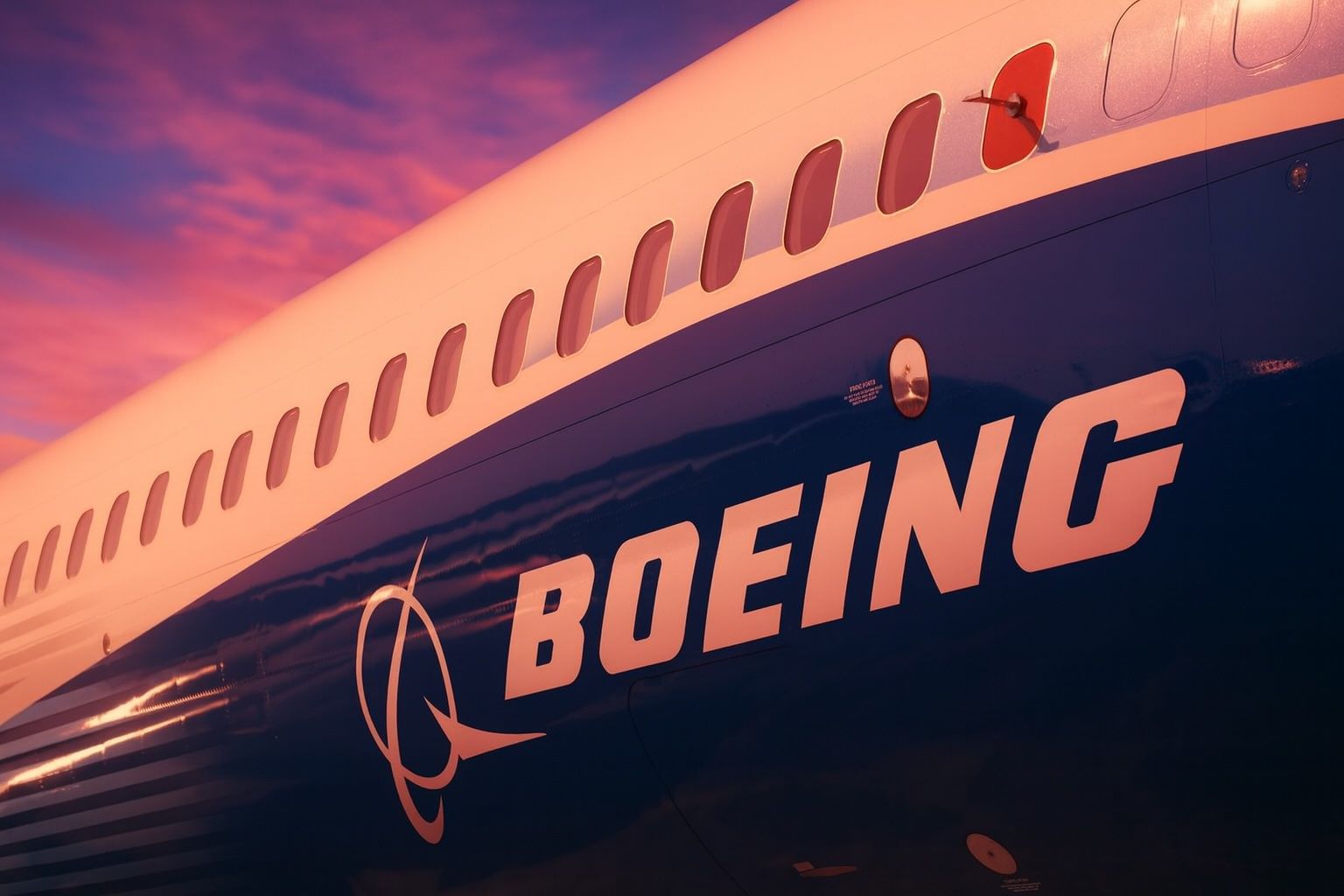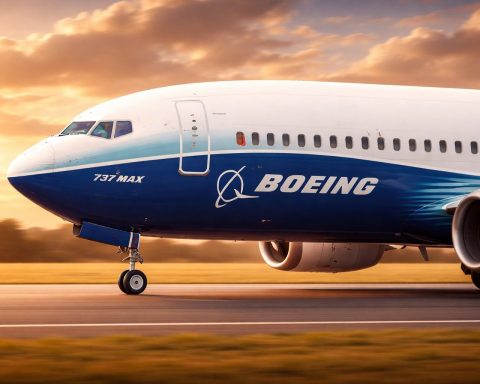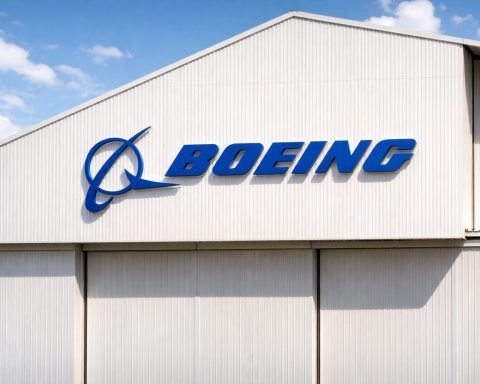- FAA Lifts Production Cap: U.S. regulators cleared Boeing to boost 737 MAX output to 42 jets per month, lifting a two-year cap of 38 after safety reviews [1] [2]. Boeing is moving swiftly to ramp up production as workers prep factory upgrades [3].
- EU Approves Spirit Takeover: The EU gave antitrust approval to Boeing’s $4.7 billion acquisition of supplier Spirit AeroSystems, on condition Boeing divest all Spirit’s Airbus-related business [4] [5]. The deal, aimed at fixing supply chain snags, now awaits U.S. sign-off [6].
- Striking Workers Stall Jets: A 75-day strike by 3,200 Boeing defense workers in St. Louis has delayed F-15EX fighter deliveries to the U.S. Air Force [7]. The union filed an unfair labor practice charge and will resume contract talks Monday with a federal mediator [8].
- Stock Surges on Good News: Boeing’s stock (NYSE: BA) jumped in late-week trading as positive headlines rolled in. Shares rose ~1.5% to the mid-$210s after hours Friday on word of the FAA go-ahead [9]. Year-to-date, BA is up about 20%, handily beating the S&P 500, though it remains volatile.
- International Twists: President Donald Trump threatened to ban Boeing part exports to China in retaliation for Beijing’s rare-earths curbs [10], then dialed back after high-level talks cooled tensions [11] [12]. Meanwhile, U.S. officials touted a possible sale of 500 Boeing jets to China – a breakthrough deal reportedly in final stages [13] [14].
Financial Performance & Deliveries
Boeing’s financial recovery is gathering pace, though the company isn’t profitable yet. In Q2 2025, revenue surged to $22.75 billion (+35% year-on-year) while losses narrowed to $612 million (vs. a $1.44 billion loss a year prior) [15]. Crucially, free cash flow turned positive – a milestone after years of cash burn [16]. Boeing’s backlog has swelled to about $619 billion (~5,900 airplanes) as airlines snap up jets amid a travel rebound [17].
New figures underscore the momentum. Boeing delivered 55 jets in September, a sharp rise from 33 a year earlier [18]. That included 40 of its 737 MAX workhorses – one of which marked the 2,000th 737 MAX delivery to date [19]. The company also handed over several wide-bodies (777 freighters, 767s, and 787 Dreamliners) and even a P-8 military patrol plane conversion [20]. Notably, eight aircraft went to Chinese customers (six 737 MAX, a 787 and a 777F), hinting at thawing relations [21]. Through the first nine months, Boeing’s 440 deliveries still trailed Airbus’s 507 [22] [23] – but the gap is narrowing as Boeing’s factories recover from past disruptions.
While full Q3 earnings are due later this month, investors are optimistic that rising deliveries will bolster revenues and cash. Boeing gets paid largely upon jet delivery, so the recent uptick bodes well for its second-half financials [24]. Executives have forecast turning cash-flow positive by Q4 2025 barring setbacks [25]. However, the company’s debt remains a concern – roughly $53 billion in total debt versus about $23 billion in cash – a “trouble” spot that requires continued improvement in fundamentals to manage [26]. In other words, Boeing is not out of the woods yet, but the trend-lines are pointing up.
Aviation Safety Oversight
Aviation safety has been front-and-center after Boeing’s high-profile quality lapses in recent years. The FAA’s latest move to lift the 737 MAX production cap came only after “extensive reviews” of Boeing’s assembly lines confirmed a modest rate hike can be done safely [27]. This cap had been imposed back in January 2024 following a frightening mid-air incident on an Alaska Airlines 737 MAX that was delivered missing several critical bolts [28]. That near-disaster – the plane landed safely despite a loose panel – exposed systemic production flaws and led regulators to clamp down. Nearly two years on, Boeing’s internal fixes seem to have satisfied authorities enough to allow a 10% output bump. FAA Administrator Bryan Bedford personally called Boeing’s CEO, Kelly Ortberg, to convey the agency’s green light for 42 jets/month [29]. Boeing hailed the decision, saying it would increase production “with safety and quality at the forefront” [30].
Regulators have been gradually restoring trust in Boeing’s processes. Just a few weeks ago, on Sept. 26, the FAA even partially returned to Boeing the authority to issue airworthiness certificates on new 737 MAX and 787 jets (alternating oversight with FAA inspectors) [31]. Boeing had lost that delegated certification power after the 737 MAX crisis, so this partial restoration was seen as a vote of confidence – and it sent Boeing stock up ~5% on the day [32]. Safety advocates and the flying public will be watching closely to ensure Boeing’s quality control truly turns a corner. The company can ill afford another quality scare. As one analyst noted, hundreds of minor production compliance issues were found during heightened FAA scrutiny [33]. The recent clearance suggests improvement, but Boeing is still essentially on probation with regulators. Every additional plane rolling off the line must vindicate that renewed trust.
Aircraft Deliveries & Orders
Boeing’s delivery pipeline is accelerating, feeding much-needed cash and signaling rising airline demand. The 55 jet deliveries in September capped the strongest month for Boeing since 2018 [34]. Significantly, Ryanair received one of those 737s – which happened to be Boeing’s milestone 2,000th 737 MAX ever delivered [35]. For a jet family once grounded worldwide, it’s a symbolic comeback. Boeing also delivered a mix of 787 Dreamliners, 767s, and 777 freighters in the month, reflecting broad demand across cargo and passenger markets [36].
On the sales front, Boeing logged 96 new aircraft orders in September, outpacing cancellations for 95 net orders [37]. European discounter Norwegian Air booked 30 more 737 MAXs, and Turkey’s flagship Turkish Airlines ordered 50 Dreamliners (787s) – one of Boeing’s largest wide-body deals this year [38]. Uzbekistan Airways inked a deal for 14 Dreamliners as well [39]. Those Dreamliner orders were loudly cheered, with President Trump touting the Uzbek deal as supporting 35,000 U.S. jobs [40]. Meanwhile, Boeing’s backlog inched just below 6,000 planes after routine accounting adjustments [41], representing several years of production.
One order not yet on the books but looming large is a potential blockbuster sale to China. U.S. officials indicate China may buy up to 500 Boeing jets as relations improve [42]. Boeing hasn’t seen a major Chinese order in about five years amid trade tensions [43] [44]. Such a deal would be a historic breakthrough in the world’s second-biggest aviation market. Talks are reportedly in their “last days or weeks,” according to the U.S. Ambassador in Beijing [45]. If finalized, it could significantly boost Boeing’s order book and global standing – not to mention help mend the political rift. For now it remains a tantalizing prospect, tied to the delicate dance of U.S.-China diplomacy.
Regulatory & Strategic Moves
Beyond the FAA’s production ruling, Boeing scored a major strategic win on the regulatory front in Europe. On Oct. 14, Brussels approved Boeing’s takeover of Spirit AeroSystems, a key supplier, after Boeing agreed to significant concessions [46] [47]. Spirit builds fuselages and other parts for Boeing jets – and some Airbus models too. To ease antitrust fears, Boeing will sell off all of Spirit’s Airbus-related work, including factories that make Airbus A350 and A220 components [48]. The European Commission hailed Boeing’s commitments as preserving competition and ensuring Airbus still has alternate suppliers [49] [50]. Essentially, Boeing is only bringing “in-house” the production that feeds its own jets [51]. The deal, valued at $4.7 billion, is expected to close by year-end pending U.S. approval [52] [53].
Why buy back a supplier Boeing spun off in 2005? In short, to fix supply chain headaches. Spirit has struggled financially and grappled with quality problems that disrupted Boeing’s jet output [54]. By reintegrating Spirit’s Boeing-focused operations, Boeing hopes to tighten oversight, avoid delays, and secure critical parts supply [55] [56]. It’s an unusual reversal that underscores how severe supply woes have been – a “desperate times, desperate measures” scenario. Some industry experts warn absorbing a big supplier is risky and could create integration challenges [57]. But if executed well, it could stabilize production and cut costs long-term. Wall Street is watching closely. With Airbus running ahead in deliveries, Boeing needs every efficiency gain it can get.
In other strategic news, Boeing continues to invest in future technology and defense programs. Last month, it announced a partnership with Palantir to apply AI and big data analytics on its factory floors to boost production efficiency [58] [59]. It’s also chasing next-gen military projects – pouring R&D into a 6th-generation fighter jet program and autonomous drones – to secure its slice of future defense budgets [60] [61]. These moves won’t pay off overnight, but they show Boeing looking beyond crisis management toward long-term innovation. Likewise on sustainability: Boeing is researching cleaner fuels and concepts like hybrid-electric aircraft to meet climate goals, even if such initiatives get fewer headlines.
Labor and Legal Challenges
Boeing’s labor relations hit turbulence this week as a prolonged strike drags on in Missouri. Over 3,200 union machinists and technicians who build F-15 fighters, F/A-18 components, and missiles for Boeing’s defense division walked off the job on August 4 [62]. After rejecting multiple contract offers over pay, benefits, and job security, they are now in their 11th week on strike – the longest at Boeing in decades. The work stoppage has already delayed new F-15EX fighters for the U.S. Air Force, forcing a base in Portland to postpone introducing the modernized jets [63]. A top Air Force general warned that the delays will impact readiness and an overseas deployment of the F-15EX next year [64].
Tensions escalated on Thursday when the union filed an unfair labor practice charge accusing Boeing of bad-faith bargaining [65]. In response, Boeing had threatened to hire permanent replacements – a move the union blasted as a bluff, since special skills and clearances take months to acquire [66]. The dispute even drew fire from U.S. senators on both sides of the aisle, who lambasted Boeing’s hardline stance during a recent hearing [67]. Facing mounting pressure, both parties agreed to return to the table with a federal mediator on Oct. 20 [68]. Workers on the picket line and Boeing’s defense customers alike will be hoping for a deal to finally end the impasse.
Meanwhile, Boeing quietly put to rest a haunting legal case stemming from its past safety troubles. The company settled a wrongful-death lawsuit filed by the mother of John Barnett, a former quality manager turned whistleblower [69]. Barnett had raised alarms about manufacturing defects he felt were “potentially putting passengers at risk,” and was in the midst of testifying in a retaliation case when he tragically took his own life in 2024 [70] [71]. In the settlement, Boeing paid the family a token $50,000 while denying wrongdoing [72]. The case highlights the human toll of Boeing’s safety crisis and suggests the company is trying to close the book on related legal battles. Boeing still faces civil suits from some 737 MAX crash victims’ families and ongoing oversight from a deferred prosecution agreement over fraud charges, underscoring that accountability remains a work in progress.
Stock Market Impact
Boeing’s stock spent much of 2025 climbing, and this week’s flurry of developments gave investors more to chew on. The FAA production boost news in particular was greeted as a bullish signal for Boeing’s finances – more jets out the door means more cash coming in. Boeing shares jumped about 1.2–1.6% in post-market trading on Friday on reports of the FAA’s sign-off [73]. The stock closed near $215, extending a roughly 20% year-to-date gain (versus ~12% for the Dow Jones index). In fact, over the past 12 months Boeing stock has soared around +40%, dramatically outperforming the broader market [74] [75]. Analysts attribute the rally to surging travel demand, Boeing’s improving delivery volumes, and optimism that the worst of its crises are over [76].
Still, Boeing’s share price is prone to turbulence. Just last month, negative headlines around production delays and labor unrest knocked the stock off summer highs in the $230s [77] [78]. It dipped into the low $210s amid that uncertainty [79] [80]. The recent rebound suggests traders are now focusing on the positive catalysts: major new orders, easing regulatory shackles, and potential peace with China’s market. Importantly, Wall Street is growing more upbeat. Bank of America raised its price target for Boeing to $270 on Oct. 17 and reiterated a “Buy” rating [81] – implying substantial upside if Boeing executes well. The consensus 12-month target among analysts hovers around $230–$235 [82], so BofA’s call stands out as particularly bullish.
Investors will watch Boeing’s upcoming Q3 earnings report for concrete signs of progress (profits, cash flow) to support the stock’s run. With no dividend since 2020 and a still-rich valuation, Boeing needs to hit its financial goals to keep shareholders on board. Any stumble in the production ramp-up or prolonged strike could weigh on the stock. Conversely, a blockbuster China order or quicker return to profitability would be rocket fuel. As one market strategist quipped, Boeing remains a “show me” story – confidence is rising, but now the company must deliver results consistently.
International Relations and Trade
The past week laid bare how geopolitics and aerospace are entwined for Boeing. In a startling move, President Trump on Oct. 10 floated the idea of blocking Boeing spare parts exports to China – essentially grounding Chinese fleets of Boeing jets – in retaliation for Beijing’s limits on exporting rare-earth metals [83]. China relies on U.S. parts to keep some 1,850 Boeing aircraft flying [84] [85]. Trump noted China “needs parts, and lots of things like that” for its Boeing planes, implying the U.S. could wield that as leverage [86] [87]. Such a ban would also hit engine-maker GE and other suppliers [88]. While analysts said the financial hit to Boeing itself would be “sandpaper on the hide” (Chinese orders are under 5% of its backlog) [89] [90], the diplomatic shockwaves would be immense.
Fortunately for Boeing, cooler heads prevailed over the weekend. By Monday Oct. 13, U.S. officials walked back the threat after “substantial communications” with Beijing eased the rare-earth spat [91]. Treasury Secretary Scott Bessent signaled tensions had cooled [92], and no export ban materialized. The episode, however, was a vivid reminder of Boeing’s uncomfortable position in U.S.-China crossfire. The company historically sold a quarter of its jets to China [93]. But trade wars and politics slammed that door shut after 2017. Now, even as negotiations for a huge new China deal advance, hawks in Washington aren’t shy about using Boeing’s business as a bargaining chip.
Elsewhere, Boeing’s fortunes are tied to global diplomacy in other ways. The EU’s approval of the Spirit deal shows transatlantic cooperation – Brussels even endorsed a Malaysian firm to take over Spirit’s Airbus work to ensure a new non-Boeing supplier enters the market [94] [95]. In the Middle East, Boeing is courting airlines flush with petrodollars; rumors swirl of Mideast carriers eyeing more 787s and even the yet-to-be-launched 777X. And in Ukraine and Eastern Europe, demand for defense hardware (from drones to fighters) could benefit Boeing’s military side if U.S. allies go on buying sprees. In short, Boeing’s international outlook involves both huge opportunities (e.g. China re-opening, defense exports) and delicate risks (trade barriers, sanctions). The coming months will test Boeing’s ability to navigate the geopolitical headwinds and tailwinds.
Expert Outlook
Industry experts generally agree Boeing is on a recovery trajectory – but with plenty of caveats. Aviation analyst Scott Hamilton observed that even if the massive China order “falls through, the financial hit to Boeing will likely be small” given how the company reduced reliance on China [96] [97]. In other words, Boeing’s resurgence doesn’t hinge on any single geopolitical win. More crucial is execution: ramping up production without new snafus, integrating Spirit AeroSystems smoothly, and concluding labor deals. Barclays’ aerospace analyst David Strauss cautioned that investor excitement might be running ahead of reality, calling a recent rally “surprising” in light of Boeing’s lingering challenges [98]. He and others stress that Boeing must prove it can deliver 42+ jets per month consistently and boost profitability [99].
At the same time, confidence is slowly returning. Market surveys show the majority of analysts rate Boeing a “Buy” or equivalent, reflecting optimism about long-term aircraft demand [100] [101]. The consensus is that Boeing’s management is turning the ship around – evidenced by steady progress on financial metrics and a calmer regulatory climate. Yet skeptics point to Boeing’s hefty debt load and still-negative earnings as reasons for caution [102] [103]. There’s also the matter of Airbus: the European rival isn’t standing still and still leads in deliveries, so Boeing has ground to make up [104] [105].
Overall, the tone among experts is guarded optimism. The past few days’ developments – FAA sign-off, EU deal approval, strike negotiations – address some key uncertainties. Each resolved issue removes a “blocker” from Boeing’s path to recovery. But as one aviation journalist put it, “Boeing is juggling FAA oversight, supplier fixes, and labor negotiations even as it tries to increase output” [106]. Any serious stumble, be it a new manufacturing flaw or an extended work stoppage, could undercut the comeback story [107]. For now, Boeing’s management appears to be managing the crises and keeping the production lines moving. If it can keep threading that needle – boosting output and upholding safety and quality – then 2025 might mark the beginning of a new chapter: one where Boeing is back in the sky, stronger and wiser from the storms it navigated.
Sources: Reuters, ts2.tech, Boeing investor statements, and other industry reports [108] [109] [110] [111] [112]. (All information is sourced from verified reporting; quotes are from original Reuters coverage and expert commentary.)
References
1. www.reuters.com, 2. www.reuters.com, 3. www.reuters.com, 4. www.reuters.com, 5. www.reuters.com, 6. www.reuters.com, 7. www.reuters.com, 8. www.reuters.com, 9. www.bloomberg.com, 10. www.reuters.com, 11. www.reuters.com, 12. www.reuters.com, 13. www.reuters.com, 14. www.reuters.com, 15. ts2.tech, 16. ts2.tech, 17. ts2.tech, 18. www.reuters.com, 19. www.reuters.com, 20. www.reuters.com, 21. www.reuters.com, 22. www.reuters.com, 23. www.reuters.com, 24. www.reuters.com, 25. ts2.tech, 26. ts2.tech, 27. www.reuters.com, 28. www.reuters.com, 29. www.reuters.com, 30. www.reuters.com, 31. ts2.tech, 32. ts2.tech, 33. ts2.tech, 34. www.reuters.com, 35. www.reuters.com, 36. www.reuters.com, 37. www.reuters.com, 38. www.reuters.com, 39. www.reuters.com, 40. ts2.tech, 41. www.reuters.com, 42. www.reuters.com, 43. www.reuters.com, 44. www.reuters.com, 45. www.reuters.com, 46. www.reuters.com, 47. www.reuters.com, 48. ts2.tech, 49. www.reuters.com, 50. www.reuters.com, 51. ts2.tech, 52. www.reuters.com, 53. www.reuters.com, 54. ts2.tech, 55. ts2.tech, 56. ts2.tech, 57. ts2.tech, 58. ts2.tech, 59. ts2.tech, 60. ts2.tech, 61. ts2.tech, 62. www.reuters.com, 63. www.reuters.com, 64. www.reuters.com, 65. www.reuters.com, 66. www.reuters.com, 67. www.reuters.com, 68. www.reuters.com, 69. www.reuters.com, 70. www.reuters.com, 71. www.reuters.com, 72. www.reuters.com, 73. www.morningstar.com, 74. ts2.tech, 75. ts2.tech, 76. ts2.tech, 77. ts2.tech, 78. ts2.tech, 79. ts2.tech, 80. ts2.tech, 81. www.marketbeat.com, 82. ts2.tech, 83. www.reuters.com, 84. www.reuters.com, 85. www.reuters.com, 86. www.reuters.com, 87. www.reuters.com, 88. www.reuters.com, 89. www.reuters.com, 90. www.reuters.com, 91. www.reuters.com, 92. www.reuters.com, 93. www.reuters.com, 94. www.reuters.com, 95. www.reuters.com, 96. www.reuters.com, 97. www.reuters.com, 98. ts2.tech, 99. ts2.tech, 100. ts2.tech, 101. ts2.tech, 102. ts2.tech, 103. ts2.tech, 104. www.reuters.com, 105. www.reuters.com, 106. ts2.tech, 107. ts2.tech, 108. www.reuters.com, 109. www.reuters.com, 110. www.reuters.com, 111. www.reuters.com, 112. www.reuters.com










